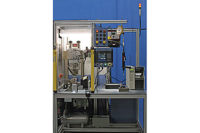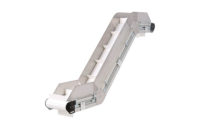The lives of manufacturers would be so much easier if all their automation processes were homogeneous. Unfortunately, there are many that require customization to satisfy the unique requirements of an automated work-holding or material-handling application. This is the case for any application that involves some combination of manual clamps, end effectors, grippers and indexers.
At this point, it serves to acknowledge that there is a significant difference between a customized “product” and a customized “system,” and we must warn that using the terms interchangeably is not correct or recommended.
A customized product is a component that has been modified to fit the needs of a specific application. On the other hand, a customized system pieces together components from different families of products—some of which may, indeed, have been customized—into a system that satisfies the needs of the application. Differentiating between the two is similar to knowing that while all champagne is sparkling wine, not all sparkling wine is champagne.
This article will focus on the creation of customized automated work-holding and material-handling systems and the steps that must be completed from drawing board to final construction to ensure that the needs of the end-user will be met.
Communication Is Key
The process of creating a customized system begins when the end-user reaches out to the designer of the proposed system. At this stage, the most important thing is to describe what needs to be moved from point A to point B. The designer needs to know the weight, size and shape of the object that needs to be moved, as well as the speed at which the procedure must be completed.
Other process-related questions that may need to be answered include:
- Are 3D CAD files available?
- Are samples available?
- Is the material to be handled porous?
- Is the material toxic or hazardous?
- Are cell layouts available?
- Will multiple tools be required?
- Are any videos or pictures of the cell running available?
- Do any regulatory specifications or standards need to be met?
Admittedly, there will likely be some back and forth between the designer and end-user at this stage, since the customer may only have a vague idea or simplistic outline of what the final customized system may need to look like or the tasks it will need to perform. This is where asking the right questions from the designer can help all the pieces fall into place.
To aid the information-gathering process, many designers of customized work-holding and material-handling products have created forms that can be filled out by the customer. These so-called “Solutions Forms” allow the customer to supply basic information about the process (picking up from? dropping off to?), along with specific information regarding, for example, what other types of automation equipment (robot, gantry, crane, etc.), tool-changing equipment (manual, automatic, none) and vacuum equipment (venturi, port only, automatic release, etc.) will also be part of the system.
All the information gathered in the initial communication phase will be used by the designer to determine which components are needed (and if any of them will need to be customized) to build the final customized system.
Five Steps to Success
Once the preliminary background work has been completed and the sources for the components identified, a five-stage process begins that will lead to the creation of an engineered drawing and conceptualized model that will serve as a blueprint for construction of the final customized system.
First, a proof-of-concept drawing is created that is around 80 percent factual and notes all of the ranges that the tool needs to meet the end-user’s specifications. Providing a drawing to review is easier than trying to verbally explain the system to the customer. The customer will review this drawing and let the designer know if it meets the operational parameters, knowing that modifications can be suggested and revisions made. When the proof-of-concept drawing is approved, the designer can provide the customer with a preliminary timeline and budget that will be needed to bring the project to completion.
When the customer signs off on the design, the actual design phase is initiated, which, depending on the complexity of the system that needs to be built, typically lasts from four to eight weeks.
Once the customer delivers the purchase agreement, the designer verifies the scope of work that will need to be performed. Known as a
“0 percent kickoff” review, this process is a confirmation of the specs that were spelled out in Step 1.
Next, design reviews are conducted at key project milestones to ensure that all required parameters for fit, form and function of the final system will be met, as well as the timeline for completion. Many designers will also use standard timeline documents that indicate start and finish dates for a wide array of project-related tasks and whether or not those schedules have been met. If needed, modifications are made, which may or may not require a revised request for quote.
When the design has been roughly 50 percent completed, the designer provides 2D drawings and a bill of materials (BOM) for the system, along with all electrical and pneumatic schematics. These drawings will either be approved by all parties or undergo further modifications. If the drawings are approved, the project is released into the manufacturing phase, with constant timeline updates provided to keep all constituencies apprised of the system’s progress toward completion.
At the end of the manufacturing phase, the customer is brought in for 100 percent build review and given an opportunity to see the customized
system function in a real-world application. At this time, the designer will take quality-check photos or videos of the completed system, which will be used to compare the operation of the completed project to its intended original design. When operational approval, or “buy-off,” is given by the end-user, the finished system—along with an installation, operation and maintenance manual and parts list—is shipped to the customer’s plant for installation and deployment in the automated work-holding or material-handling process.
Benefits of Customized Systems
Consistent communication between the designer, suppliers and end-user is critical to creating a customized system that meets the needs of the work-holding or material-handling application. Beyond the equipment itself, working with a custom-automation expert can have some ancillary benefits that can lead to a strong partnership between the designer and end-user. These include:
- The ability to complete the system design faster, by leveraging a custom-automation expert to design and build a portion of the machine. Alone, the end-user might struggle to develop a customized system.
- Expertise on custom-automation applications that the end-user may not be familiar with or aware of.
- Higher throughput, lower operational costs, and a stronger bottom line.
- A baseline of trust and reliability between the designer and end-user that can serve as the foundation for future customized projects.
Variety is the spice of life. However, for manufacturers that rely on automated work-holding and material-handling equipment in their processes, any deviation from the norm can present challenges. When a customized system is required, manufacturers can benefit by working directly with designers who are experienced and adept at taking an idea and creating a blueprint that will result in a finished system that meets every need.
The keys are open lines of communication from first contact to finished product, and selecting a partner that has experience with customization. When end-users, designers and suppliers work in harmony, the result will be the timely creation of a customized system that is of the highest quality. The ultimate success is a system that meets all of the end-user’s needs and that leads to optimized production schedules and streamlined operational costs.






